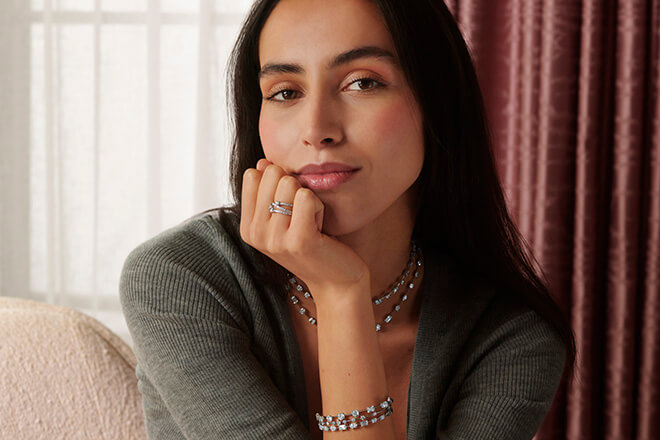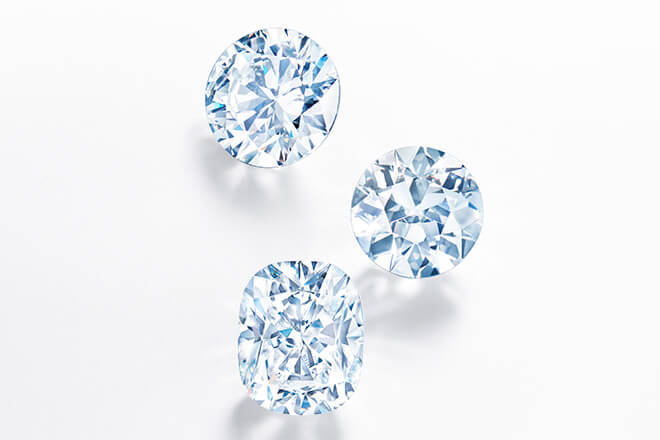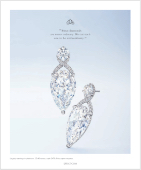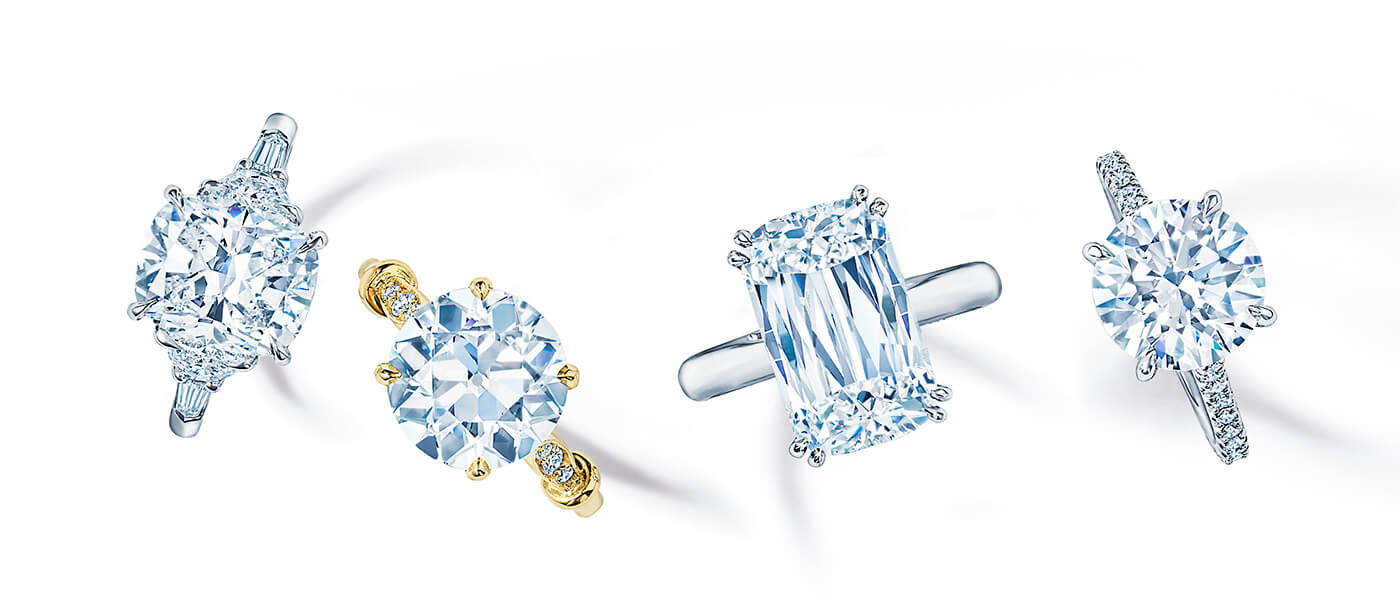Whether it’s a classic design like a solitaire, a sleek modern shape, or a vintage-inspired beauty, your engagement ring should reflect your personal style. Other factors to consider when selecting the perfect engagement ring include your favorite metal color and even your lifestyle.
At Kwiat, we offer a wide range of engagement ring styles to choose from, whether you prefer an antique look or a more modern aesthetic. We can also create a custom design that is uniquely yours. Our goal is to help you find an engagement ring that you will love and cherish for a lifetime.
Which Engagement Ring Style is Right for You?

Solitaire Rings
One of the simplest settings is the solitaire. It displays a single diamond and can be any shape.
Pros: The pros of solitaire rings include their beauty, sparkle, and timeless design. There is no engagement ring style that is more popular than the solitaire.
Cons: Since all focus is on that single diamond — i.e. there are no side stones or pavé diamonds to add to the look — you may desire a larger carat weight in order to get the size appearance you want. Fortunately, every Kwiat Tiara Diamond is perfectly cut to look bigger and brighter than other diamonds of the same carat weight. That means you get a larger look no matter which size you choose.
Three-Stone Rings
An engagement ring with three diamonds of similar size is called a three-stone setting. The trio is seen as symbolizing the past, present, and future of a relationship.
Pros: This setting offers plenty of sparkle. Plus, you can accompany a diamond with another gemstone — such as sapphire — if you’d like to add some color.
Cons: In some three-stone rings, the stones sit higher above the ring’s band. As a result of the ring’s height, it may be susceptible to knocking against hard objects or snagging on clothing. At Kwiat, however, our three-stone rings are designed to be streamlined for everyday wear.


Side-Stone Rings
It’s common to assume that a three-stone ring and a ring with side stones are the same thing, but they are a bit different. While “three-stone” usually refers to a ring with three stones of the same shape and similar size, as explained above, a ring with side stones features a main diamond (or other gemstone) as its center stone, while the stones on either side of it are much smaller and often a different shape.
Pros: A ring with side stones is a timeless classic with lots of sparkle. You’ll see less of the metal band and more diamonds. It also offers you a chance to get creative — there are so many side stone types to choose from: baguette, half-moon, pear, Cadillac (a five-sided stone in the shape of the car’s famous logo), and more.
Cons: As with three-stone rings, those with side stones have a higher chance of snagging clothes or irritating your fingers while working with your hands. Plus, with all the choices in shapes, it takes an expert eye to know which diamonds will best compliment your center diamond. That’s where Kwiat comes in.
Diamond Halo Rings
As the name implies, halo ring settings consist of small diamonds placed around a center stone to create a shimmering border. Haloes can take any shape to fit the center stone, and the cut of the smaller diamonds can vary too.
Pros: It’s a versatile setting that comes in many designs, including single or multiple halos, and different shapes such as round, square, cushion, or pear. Because the smaller diamonds increase the overall diamond surface area, they create the effect of a larger center stone.
Cons: The size of the ring is a matter of taste — if you prefer subtlety, a halo ring may not be for you. Furthermore, a truly spectacular diamond often deserves all the attention. A halo can detract from it.

Pavé Diamonds
Pavé, pronounced pa-vay, is derived from the French word meaning “to pave.” As a cobblestone road is paved with rocks, pavé jewelry is paved with diamonds. The gemstones are held tightly together using tiny beads of metal to create a dazzling surface. Pavé set diamonds are often used as an enhancement in engagement rings.
Pros: In terms of aesthetics, pavé settings are exquisite and complement many settings for a center stone. More diamond facets equals more brilliance.
Cons: Over time, very small pavé-set diamonds may become loose if you have an active lifestyle or use your hands frequently. If you choose a pavé setting, you’ll want to be sure to bring your ring to an expert for regular servicing. Kwiat offers complimentary servicing for a lifetime, including inspection, cleaning, and tightening of prongs to secure diamonds.

Bezel Setting
In a bezel setting, the diamond is held in place by a rim of precious metal. Bezels are commonly used for a solitaire setting, but they may also be used for halo styles — a center stone surrounded by smaller ones.
Pros: Bezel settings are known as the most secure because they hold the stone firmly in place and protect it. These settings are perfect if you are an active person and frequently use your hands.
Cons: Compared to other settings, bezel settings expose less of the stone to light. If the sides of the diamond are covered by metal, the diamond may appear less brilliant.


Bezel Setting
For the bride who seeks individuality and an antique look, a vintage style ring may be the perfect choice. And you don’t need to inherit an heirloom to wear a ring that looks like it once belonged to your great-great-grandmother. Kwiat, founded in 1907, and owner of renowned antique jewelry house, Fred Leighton, is an expert in jewels of yesteryear. Whether you want an actual antique, or a ring inspired by one, there are plenty of options.
Pros: The designs of vintage and antique rings are more unique, so they’re a great choice if you want a ring that looks different from the typical styles. Vintage style rings often feature filigree, rose-cut diamonds, colored gemstone details, and other exceptional features that are hard to find.
Cons: Due to their exquisite detail, vintage style engagement rings can require more attentive and specialized maintenance.
Best Metal Settings for Engagement Rings
While there are many things to consider, choosing the right metal for your engagement ring is one of the most vital. There are pros and cons to both platinum and gold.
Yellow Gold
This metal has been used for wedding and engagement rings throughout history and is equally suited to vintage-style settings like this 18k yellow gold engagement ring or modern, trendy designs like this east-west style. Yellow gold is more hypoallergenic compared to rose or white gold, and it is especially flattering on skin with olive or yellow undertones, as well as darker skin tones. A ring made of yellow gold may be more vulnerable to dents and scratches than platinum, and over many years, tiny amounts of gold will wear away. This causes rings to gradually become thinner at areas of more intense wear, like the underside of the band.
White Gold
Gold is naturally yellow. It’s mixed with alloys like zinc, nickel, and copper to create white gold engagement rings. The ring is then plated with rhodium to give it a bright white effect. With time, this plating will wear off, requiring periodic replating to refresh its color. If you have sensitive skin, be cautious — the nickel content of white gold may cause allergic reactions for some people.
Rose Gold
Many consider this lustrous pinkish metal, as used in our Round Brilliant Diamond Engagement Ring, to be the most romantic. Pure gold is mixed with copper and silver alloys to strengthen the gold and give the ring its rose-colored appearance. Rose gold is more durable due to its copper content, making it more resistant than white or yellow gold. Unfortunately, this metal is not hypoallergenic and can cause allergic reactions for some people.
Platinum
One of the most highly prized metals in the world, it is also one of the most durable. A platinum setting, like in our engagement ring with a round diamond and pavé, will hold its shape with wear and keep precious stones securely in place. Platinum jewelry is relatively pure, comprising 95% platinum and only 5% other metals like palladium. It maintains its white color and is hypoallergenic. Interestingly, unlike gold, when platinum is scratched, metal isn’t actually removed from the piece — it’s just “displaced,” and can be smoothed back into place by polishing. Many people treasure the patina that platinum develops and consider it a symbol of how long they’ve been with their significant other.

























